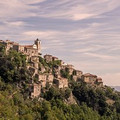的点评
Technical Marvel for its Time.
Solkanski Most的点评
点评:I biked by this bridge while visiting the Brda Region crossing back and forth between Slovenia and Italy. Beautiful area. With a span of 85 meters (279 ft), the Solkan Bridge is the world's longest stone arch railroad bridge (second longest if you count road bridges). This masterpiece was finished in 1905, as part of a railway between Gorica and Jesenice (from SW to NE Slovenia).
They used 4,533 ashlar (square-cut) blocks in its construction. The Solkan bridge holds this record because later construction technology used reinforced concrete to build bridges.
The first train from Vienna arrived at the port of Trieste in 1906. The bridge was demolished during WWI. However, they were able to rebuild it following the original plans (with the minor difference of using 4 sub-arches instead of the original 5, and slightly different curvature) and is still serving its purpose to date.
Then the bridge was spared. During WW2, it suffered only minimal damage from bomb attacks. On August 10, 1944, bombs did not hit the bridge; on March 15, 1945, the bomb that hit the bridge did not explode.
In 1985, the Solkan Bridge was acknowledged as a technical monument and thus enjoy special protection.
Enjoy the view of this grand structure over the greenish-blue water of the Soča River.
They used 4,533 ashlar (square-cut) blocks in its construction. The Solkan bridge holds this record because later construction technology used reinforced concrete to build bridges.
The first train from Vienna arrived at the port of Trieste in 1906. The bridge was demolished during WWI. However, they were able to rebuild it following the original plans (with the minor difference of using 4 sub-arches instead of the original 5, and slightly different curvature) and is still serving its purpose to date.
Then the bridge was spared. During WW2, it suffered only minimal damage from bomb attacks. On August 10, 1944, bombs did not hit the bridge; on March 15, 1945, the bomb that hit the bridge did not explode.
In 1985, the Solkan Bridge was acknowledged as a technical monument and thus enjoy special protection.
Enjoy the view of this grand structure over the greenish-blue water of the Soča River.
翻译:我在游览布尔达地区时骑自行车经过这座桥,往返于斯洛文尼亚和意大利之间。美丽的地区。索尔坎大桥跨度为 85 米(279 英尺),是世界上最长的石拱铁路桥(如果算上公路桥,则为第二长)。这座杰作于 1905 年竣工,是戈里察和耶塞尼采(从斯洛文尼亚西南部到东北部)之间铁路的一部分。
他们在建造过程中使用了 4,533 块方石(方形切割)块。索尔坎桥保持着这一记录,因为后来的建筑技术使用了钢筋混凝土来建造桥梁。
1906 年,第一列从维也纳出发的火车抵达的里雅斯特港。这座桥在第一次世界大战期间被拆除。然而,他们能够按照最初的计划重建它(细微差别是使用 4 个子拱而不是原来的 5 个,并且曲率略有不同),并且至今仍在发挥其作用。
然后这座桥就幸免了。第二次世界大战期间,它仅因炸弹袭击而受到最小程度的损害。 1944 年 8 月 10 日,炸弹没有击中桥; 1945年3月15日,击中大桥的炸弹没有爆炸。
1985年,索尔坎大桥被认定为技术纪念碑,因此受到特殊保护。
欣赏索察河蓝绿色水面上这座宏伟建筑的景色。
他们在建造过程中使用了 4,533 块方石(方形切割)块。索尔坎桥保持着这一记录,因为后来的建筑技术使用了钢筋混凝土来建造桥梁。
1906 年,第一列从维也纳出发的火车抵达的里雅斯特港。这座桥在第一次世界大战期间被拆除。然而,他们能够按照最初的计划重建它(细微差别是使用 4 个子拱而不是原来的 5 个,并且曲率略有不同),并且至今仍在发挥其作用。
然后这座桥就幸免了。第二次世界大战期间,它仅因炸弹袭击而受到最小程度的损害。 1944 年 8 月 10 日,炸弹没有击中桥; 1945年3月15日,击中大桥的炸弹没有爆炸。
1985年,索尔坎大桥被认定为技术纪念碑,因此受到特殊保护。
欣赏索察河蓝绿色水面上这座宏伟建筑的景色。
此点评仅代表旅行者个人的主观意见,并不代表TripAdvisor以及其合作方的意见。
关于我们
|
新闻动态
|
商务合作
|
会员中心
|
业主中心
|
业主通
|
常见问题
|
意见反馈
|
联系我们
|
营业执照
© 2025 Tripadvisor 版权所有。
使用条款 |隐私政策 |网站工作原理
部分照片由 VFM Leonardo 提供。
* Tripadvisor不是旅行社,也不是旅游预订服务代理商。我们提供免费、客观、公正的旅游资讯服务。 (显示更多)
TripAdvisor LLC 既不是预订代理商,也不是旅游运营商,不会向网站用户收取任何服务费。 按照规定,在 Tripadvisor 发布机票价格、游览和旅行套餐的合作伙伴(航空公司、旅行提供商及预订代理商),其标价须包含所有费用和附加费用。 例如, 机场出入境税费、消费税与其他服务费、手续费、杂费及附加费用。 当您向我们的某个合作伙伴进行预订时,请务必查阅他们的网站以了解当地行政部门要求的所有适用费用的具体情况。 除非另有说明,机票价格通常指的是一个人的价格(以人民币计)。
为方便起见,TripAdvisor LLC 根据从我们的预订合作伙伴获取的空房率计算每个酒店的均价。 对于游览和景点来说,所显示价格通常是每位成人的最低可用价格。 对于列出的任何旅行套餐或优惠,TripAdvisor LLC 无法保证任何特定的费率或价格。 此外,酒店均价每晚会更新,并以您的首选币种表示(使用现行汇率)。 由于这些已换算的价格是预估价格,因此,有关具体金额和币种请与预订网站进行核实。
此外,TripAdvisor LLC 无法保证我们网站上宣传的价格随时有效。 标价可能需要预订一定天数才能生效,或有不可用日期、使用条件或限制。
TripAdvisor公司对外部网站的内容一概不负责。优惠价格中不含税和其他费用。
ICP证:沪B2-20200433
沪ICP备20013175号
 沪公网安备31010502005427号
沪公网安备31010502005427号鹰程信息技术(上海)有限公司
货币/国家及地区
¥CNY
中国

